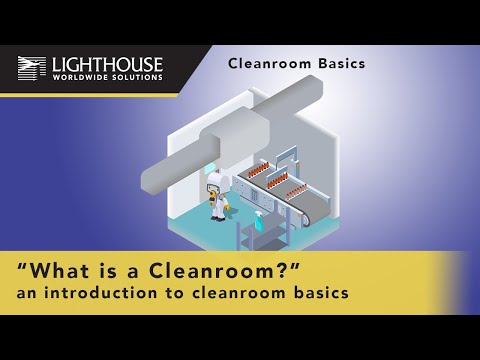Your filters are what separates your cleanroom from just some ordinary, run-of-the-mill room. They stop potentially harmful contaminants from entering the room. They prevent yield loss and harm to the end-user. Most importantly, the filters’ MPPS defines your cleanroom’s potential classification. This classification limits your cleanroom’s applications.
Cleanroom filtration is defined by the type of filters you use. There are 4 main types of filters you see in cleanrooms: pre-filters, activated charcoal filters, HEPA filters, and ULPA filters. Each one serves its own purpose and, don’t worry, we’ll let you know what those are!
Types Of Cleanroom Filters
Not all filters are created equal, both in terms of the size of particle filtered and their purpose. Before we get into the types of filters, though, it is important to define the terms we use to classify filters.
Most Penetrating Particle Size
A filter’s Most Penetrating Particle Size (MPPS) defines the diameter of the particle that is most easily able to pass through a filter. While basic intuition would say that particles smaller than the MPPS would pass through more easily, the opposite is true: particles both smaller and larger have a more difficult time passing through the filter.
This means that a filter’s efficiency removal rate, based on the MPPS, is the worst case scenario. The rate is improved for particles of other sizes, until a certain, defined size of smaller particle.
While important to understanding a filter’s efficacy and rating, the MPPS does not define how harmful a particle can be. A particle of any size can be detrimental to a product, experiment, or end-user. (That is why it is important to understand the size of particles present in your cleanroom, but more on that later.)
So what type of filters do we see in particle rooms? Let’s start with the first line of defense: pre-filters.
Pre-Filters
As the name suggests, these filters sift out larger particles before the air makes its way to the highly sensitive filters, like HEPA and ULPA filters. There are no requirements for the size of particles filtered out, but they are usually responsible solely for larger particles.
Pre-filters should be replaced about 6 times a year. While this might feel like a costly endeavor, they are more affordable than HEPA and ULPA filters. Not only are they an affordable replacement option, using them appropriately can extend the lifespan of your HEPA and ULPA filters. They prevent unnecessary, bulky contamination from clogging up these highly sensitive filters and, ultimately, save you from costly filter replacements and general repairs.
Activated Charcoal Filters
Activated charcoal filters are very porous filters that are used to absorb fumes. Charcoal is activated in different ways, but is usually done through chemical heating. Activating it opens pores that give it more surface area and increase its absorbency.
They are extremely effective at absorbing fumes in negative pressure environments. HEPA and ULPA filters do not remove odors from chemicals or by-products. These odors can be irritants, which, over time, can decrease productivity while increasing safety concerns.
Charcoal filters’ replacement timeline depends on the application and use in the cleanroom.

HEPA Filters
We see High Energy Particulate Air (HEPA) filters in cleanrooms most often. These are highly sensitive filters designed to sift out tiny particles. According to the Environmental Protection Agency (EPA), they are “a type of pleated mechanical air filter”. In theory, HEPA filters remove 99.97% of particles 0.3 microns and larger. This includes dust, pollen, mold, bacteria, and other particles.
The size 0.3 microns is HEPA filters’ most penetrating particle size (MPPS). This means that particles both larger and smaller are sifted out with even higher efficiency.
HEPA filters should be replaced every 4-6 years depending on your application. The more you do to protect the HEPA filter, the longer they will last.
ULPA Filters
The next most effective filter is an Ultra Low Particle Air (ULPA) filter. This filter has a removal efficiency of 99.9995% for particles down to 1.2 microns. While the MPPS is larger than HEPA filters’, ULPA filters specialize in capturing the smallest particles, especially those in the range of .12 to .14 microns. This makes them ideal for very specialized applications.
Not every cleanroom needs this level of cleanliness. ULPA filters do come with obstacles, such as being more restrictive than HEPA filters and added maintenance expenses, so it does not make sense to have them in every cleanroom. When they are needed, though, they work very well in conjunction with HEPA filters and do their job handily!
ULPA filters can also last several years but do need to be replaced after a few years, depending on your application and other filtration systems in place.

How To Know Your Cleanroom Filters Are Working
So how do you know that you have put into place the right filters – and they are working?
You can use a particle counter!
We recommend using a scanning particle counter to check your filters to ensure that they are operating correctly.
Since you will be lifting, moving, and navigating this piece of equipment, we recommend one that is lightweight and ergonomic. It should also be easy-to-use and highly sensitive, since its job is to identify leaks and efficacy.
Good news! The ScanAir Pro is all those things – and more. Is it the right fit for your cleanroom? If your cleanroom uses HEPA and/or ULPA filters, this particle counter filter scanning system should be the next addition to your cleanroom for ultimate security in your cleanroom filtration system.


